ALR731 Essay: Communication Strategies for Generation Alpha
VerifiedAdded on 2022/11/15
|12
|4113
|289
Essay
AI Summary
This essay addresses the critical issue of early social media adoption among Generation Alpha and the need for preventative measures. It begins by highlighting the prevalence of social media use in children aged 10-12, despite age restrictions, and the associated risks to their health, safety, and privacy. The essay then outlines the importance of implementing communication strategies to educate parents and guardians about these risks, emphasizing the need for a targeted approach. It discusses the rationale for selecting parents as the primary target audience and the use of mass media to disseminate health messages. Furthermore, the essay explores specific communication tactics, such as leveraging real-life stories and collaborating with organizations like the Australian Childhood Foundation and mental health professionals to enhance the credibility and effectiveness of the prevention program. Ethical considerations, such as age restrictions and parental oversight, are also addressed. The essay emphasizes the importance of parental self-efficacy in media usage and the need for mediation practices. Finally, the essay concludes by highlighting the significance of accurate and timely information in influencing parental behavior and the overall success of the campaign in reducing social media use among Generation Alpha.
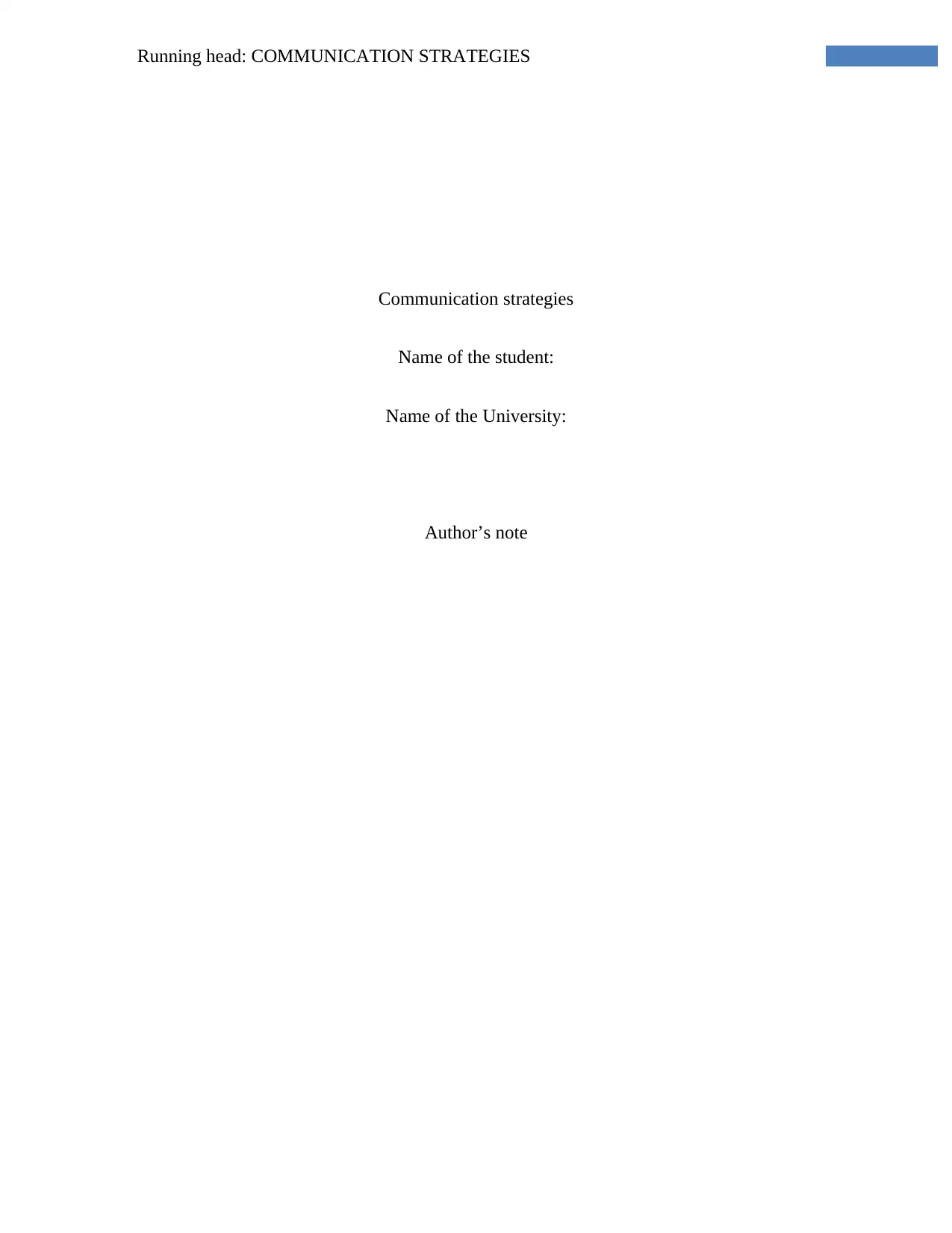
Running head: COMMUNICATION STRATEGIES
Communication strategies
Name of the student:
Name of the University:
Author’s note
Communication strategies
Name of the student:
Name of the University:
Author’s note
Paraphrase This Document
Need a fresh take? Get an instant paraphrase of this document with our AI Paraphraser
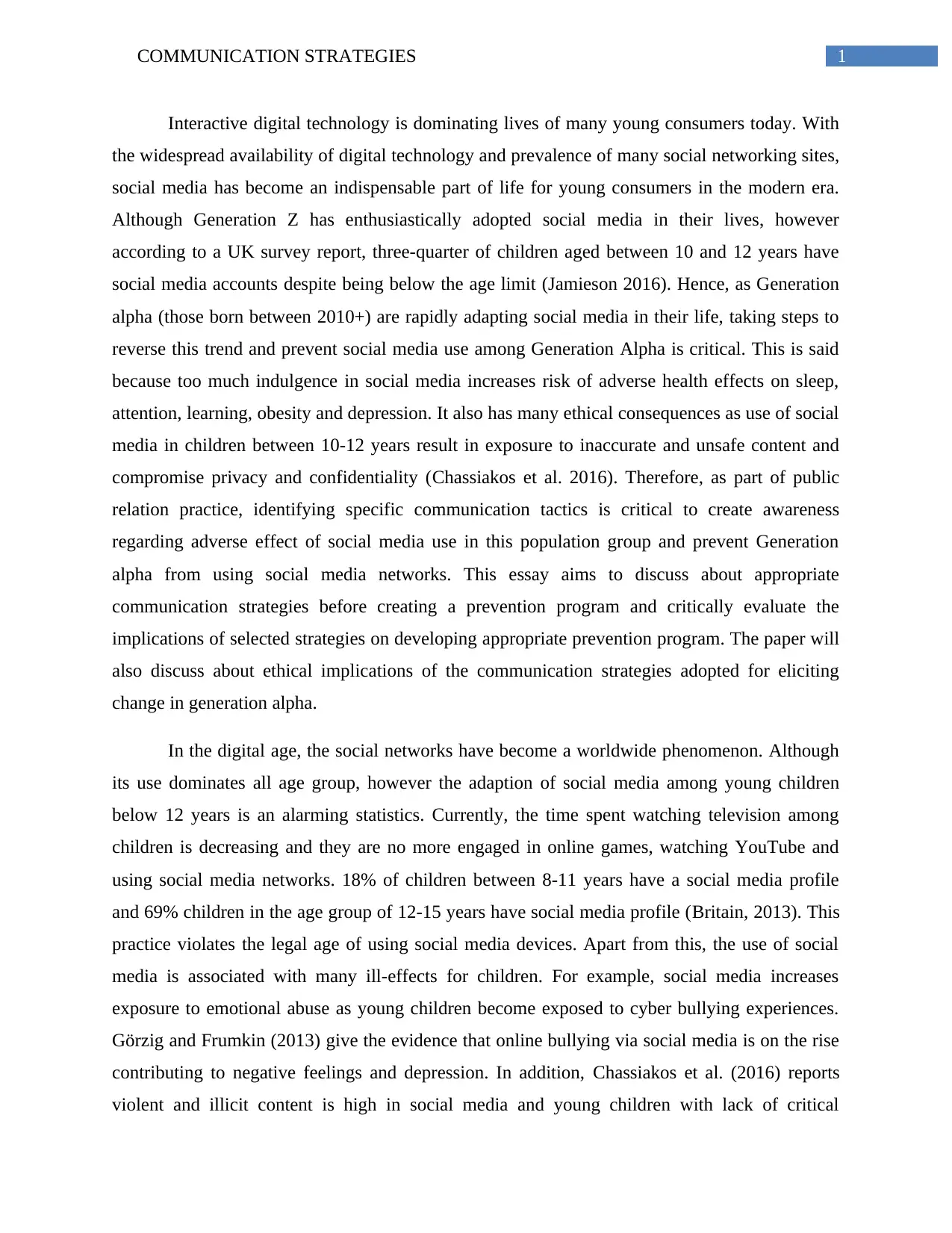
1COMMUNICATION STRATEGIES
Interactive digital technology is dominating lives of many young consumers today. With
the widespread availability of digital technology and prevalence of many social networking sites,
social media has become an indispensable part of life for young consumers in the modern era.
Although Generation Z has enthusiastically adopted social media in their lives, however
according to a UK survey report, three-quarter of children aged between 10 and 12 years have
social media accounts despite being below the age limit (Jamieson 2016). Hence, as Generation
alpha (those born between 2010+) are rapidly adapting social media in their life, taking steps to
reverse this trend and prevent social media use among Generation Alpha is critical. This is said
because too much indulgence in social media increases risk of adverse health effects on sleep,
attention, learning, obesity and depression. It also has many ethical consequences as use of social
media in children between 10-12 years result in exposure to inaccurate and unsafe content and
compromise privacy and confidentiality (Chassiakos et al. 2016). Therefore, as part of public
relation practice, identifying specific communication tactics is critical to create awareness
regarding adverse effect of social media use in this population group and prevent Generation
alpha from using social media networks. This essay aims to discuss about appropriate
communication strategies before creating a prevention program and critically evaluate the
implications of selected strategies on developing appropriate prevention program. The paper will
also discuss about ethical implications of the communication strategies adopted for eliciting
change in generation alpha.
In the digital age, the social networks have become a worldwide phenomenon. Although
its use dominates all age group, however the adaption of social media among young children
below 12 years is an alarming statistics. Currently, the time spent watching television among
children is decreasing and they are no more engaged in online games, watching YouTube and
using social media networks. 18% of children between 8-11 years have a social media profile
and 69% children in the age group of 12-15 years have social media profile (Britain, 2013). This
practice violates the legal age of using social media devices. Apart from this, the use of social
media is associated with many ill-effects for children. For example, social media increases
exposure to emotional abuse as young children become exposed to cyber bullying experiences.
Görzig and Frumkin (2013) give the evidence that online bullying via social media is on the rise
contributing to negative feelings and depression. In addition, Chassiakos et al. (2016) reports
violent and illicit content is high in social media and young children with lack of critical
Interactive digital technology is dominating lives of many young consumers today. With
the widespread availability of digital technology and prevalence of many social networking sites,
social media has become an indispensable part of life for young consumers in the modern era.
Although Generation Z has enthusiastically adopted social media in their lives, however
according to a UK survey report, three-quarter of children aged between 10 and 12 years have
social media accounts despite being below the age limit (Jamieson 2016). Hence, as Generation
alpha (those born between 2010+) are rapidly adapting social media in their life, taking steps to
reverse this trend and prevent social media use among Generation Alpha is critical. This is said
because too much indulgence in social media increases risk of adverse health effects on sleep,
attention, learning, obesity and depression. It also has many ethical consequences as use of social
media in children between 10-12 years result in exposure to inaccurate and unsafe content and
compromise privacy and confidentiality (Chassiakos et al. 2016). Therefore, as part of public
relation practice, identifying specific communication tactics is critical to create awareness
regarding adverse effect of social media use in this population group and prevent Generation
alpha from using social media networks. This essay aims to discuss about appropriate
communication strategies before creating a prevention program and critically evaluate the
implications of selected strategies on developing appropriate prevention program. The paper will
also discuss about ethical implications of the communication strategies adopted for eliciting
change in generation alpha.
In the digital age, the social networks have become a worldwide phenomenon. Although
its use dominates all age group, however the adaption of social media among young children
below 12 years is an alarming statistics. Currently, the time spent watching television among
children is decreasing and they are no more engaged in online games, watching YouTube and
using social media networks. 18% of children between 8-11 years have a social media profile
and 69% children in the age group of 12-15 years have social media profile (Britain, 2013). This
practice violates the legal age of using social media devices. Apart from this, the use of social
media is associated with many ill-effects for children. For example, social media increases
exposure to emotional abuse as young children become exposed to cyber bullying experiences.
Görzig and Frumkin (2013) give the evidence that online bullying via social media is on the rise
contributing to negative feelings and depression. In addition, Chassiakos et al. (2016) reports
violent and illicit content is high in social media and young children with lack of critical
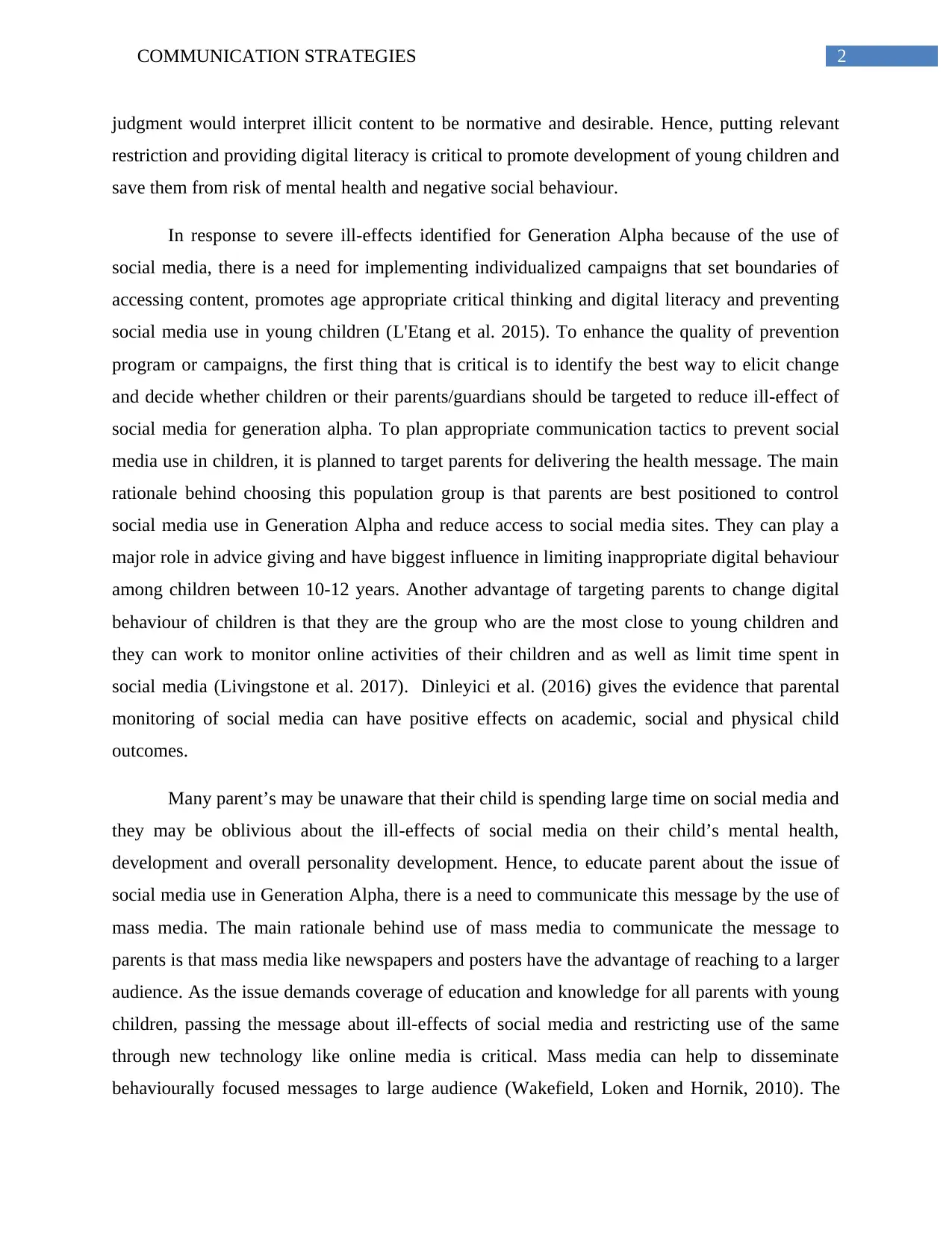
2COMMUNICATION STRATEGIES
judgment would interpret illicit content to be normative and desirable. Hence, putting relevant
restriction and providing digital literacy is critical to promote development of young children and
save them from risk of mental health and negative social behaviour.
In response to severe ill-effects identified for Generation Alpha because of the use of
social media, there is a need for implementing individualized campaigns that set boundaries of
accessing content, promotes age appropriate critical thinking and digital literacy and preventing
social media use in young children (L'Etang et al. 2015). To enhance the quality of prevention
program or campaigns, the first thing that is critical is to identify the best way to elicit change
and decide whether children or their parents/guardians should be targeted to reduce ill-effect of
social media for generation alpha. To plan appropriate communication tactics to prevent social
media use in children, it is planned to target parents for delivering the health message. The main
rationale behind choosing this population group is that parents are best positioned to control
social media use in Generation Alpha and reduce access to social media sites. They can play a
major role in advice giving and have biggest influence in limiting inappropriate digital behaviour
among children between 10-12 years. Another advantage of targeting parents to change digital
behaviour of children is that they are the group who are the most close to young children and
they can work to monitor online activities of their children and as well as limit time spent in
social media (Livingstone et al. 2017). Dinleyici et al. (2016) gives the evidence that parental
monitoring of social media can have positive effects on academic, social and physical child
outcomes.
Many parent’s may be unaware that their child is spending large time on social media and
they may be oblivious about the ill-effects of social media on their child’s mental health,
development and overall personality development. Hence, to educate parent about the issue of
social media use in Generation Alpha, there is a need to communicate this message by the use of
mass media. The main rationale behind use of mass media to communicate the message to
parents is that mass media like newspapers and posters have the advantage of reaching to a larger
audience. As the issue demands coverage of education and knowledge for all parents with young
children, passing the message about ill-effects of social media and restricting use of the same
through new technology like online media is critical. Mass media can help to disseminate
behaviourally focused messages to large audience (Wakefield, Loken and Hornik, 2010). The
judgment would interpret illicit content to be normative and desirable. Hence, putting relevant
restriction and providing digital literacy is critical to promote development of young children and
save them from risk of mental health and negative social behaviour.
In response to severe ill-effects identified for Generation Alpha because of the use of
social media, there is a need for implementing individualized campaigns that set boundaries of
accessing content, promotes age appropriate critical thinking and digital literacy and preventing
social media use in young children (L'Etang et al. 2015). To enhance the quality of prevention
program or campaigns, the first thing that is critical is to identify the best way to elicit change
and decide whether children or their parents/guardians should be targeted to reduce ill-effect of
social media for generation alpha. To plan appropriate communication tactics to prevent social
media use in children, it is planned to target parents for delivering the health message. The main
rationale behind choosing this population group is that parents are best positioned to control
social media use in Generation Alpha and reduce access to social media sites. They can play a
major role in advice giving and have biggest influence in limiting inappropriate digital behaviour
among children between 10-12 years. Another advantage of targeting parents to change digital
behaviour of children is that they are the group who are the most close to young children and
they can work to monitor online activities of their children and as well as limit time spent in
social media (Livingstone et al. 2017). Dinleyici et al. (2016) gives the evidence that parental
monitoring of social media can have positive effects on academic, social and physical child
outcomes.
Many parent’s may be unaware that their child is spending large time on social media and
they may be oblivious about the ill-effects of social media on their child’s mental health,
development and overall personality development. Hence, to educate parent about the issue of
social media use in Generation Alpha, there is a need to communicate this message by the use of
mass media. The main rationale behind use of mass media to communicate the message to
parents is that mass media like newspapers and posters have the advantage of reaching to a larger
audience. As the issue demands coverage of education and knowledge for all parents with young
children, passing the message about ill-effects of social media and restricting use of the same
through new technology like online media is critical. Mass media can help to disseminate
behaviourally focused messages to large audience (Wakefield, Loken and Hornik, 2010). The
⊘ This is a preview!⊘
Do you want full access?
Subscribe today to unlock all pages.

Trusted by 1+ million students worldwide
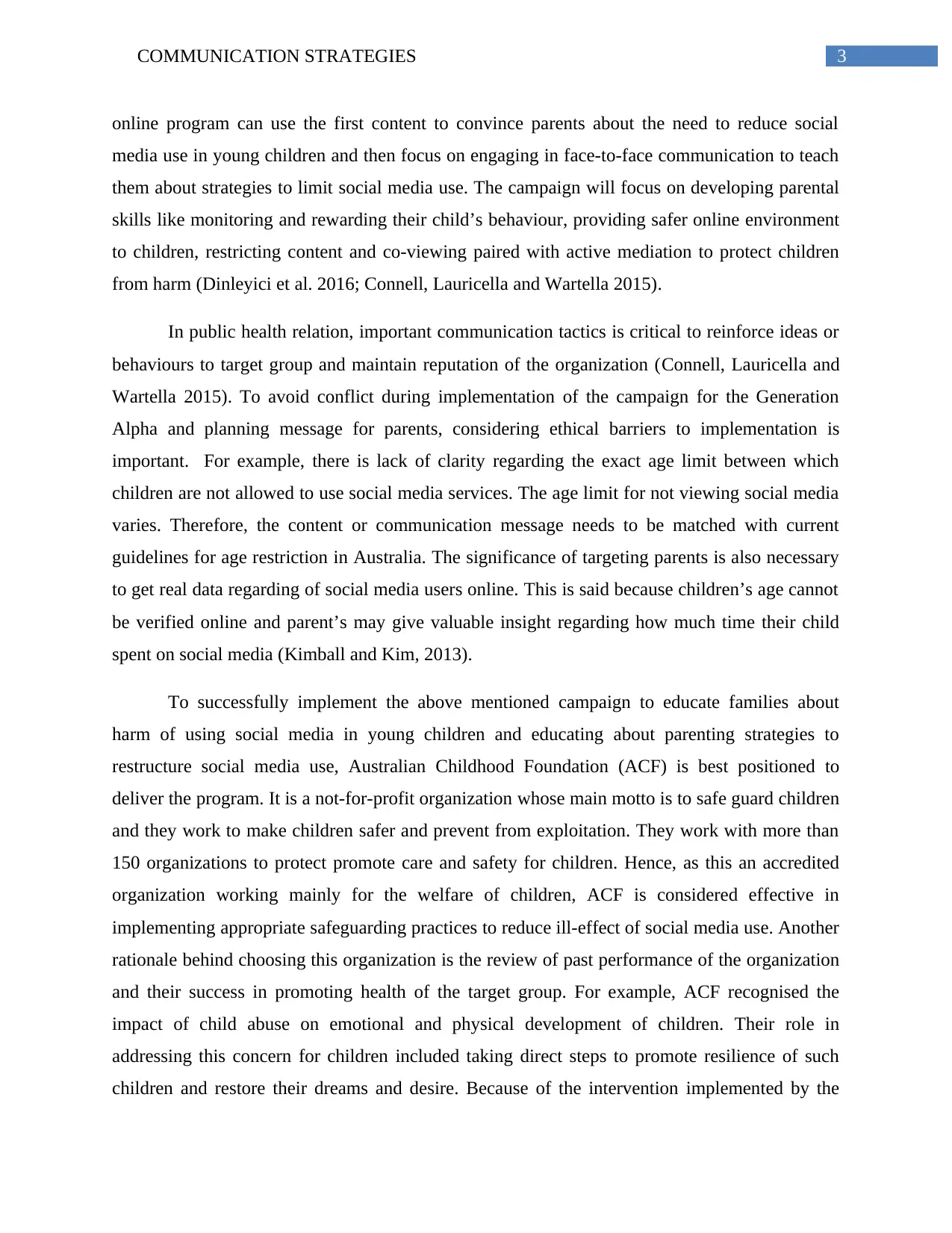
3COMMUNICATION STRATEGIES
online program can use the first content to convince parents about the need to reduce social
media use in young children and then focus on engaging in face-to-face communication to teach
them about strategies to limit social media use. The campaign will focus on developing parental
skills like monitoring and rewarding their child’s behaviour, providing safer online environment
to children, restricting content and co-viewing paired with active mediation to protect children
from harm (Dinleyici et al. 2016; Connell, Lauricella and Wartella 2015).
In public health relation, important communication tactics is critical to reinforce ideas or
behaviours to target group and maintain reputation of the organization (Connell, Lauricella and
Wartella 2015). To avoid conflict during implementation of the campaign for the Generation
Alpha and planning message for parents, considering ethical barriers to implementation is
important. For example, there is lack of clarity regarding the exact age limit between which
children are not allowed to use social media services. The age limit for not viewing social media
varies. Therefore, the content or communication message needs to be matched with current
guidelines for age restriction in Australia. The significance of targeting parents is also necessary
to get real data regarding of social media users online. This is said because children’s age cannot
be verified online and parent’s may give valuable insight regarding how much time their child
spent on social media (Kimball and Kim, 2013).
To successfully implement the above mentioned campaign to educate families about
harm of using social media in young children and educating about parenting strategies to
restructure social media use, Australian Childhood Foundation (ACF) is best positioned to
deliver the program. It is a not-for-profit organization whose main motto is to safe guard children
and they work to make children safer and prevent from exploitation. They work with more than
150 organizations to protect promote care and safety for children. Hence, as this an accredited
organization working mainly for the welfare of children, ACF is considered effective in
implementing appropriate safeguarding practices to reduce ill-effect of social media use. Another
rationale behind choosing this organization is the review of past performance of the organization
and their success in promoting health of the target group. For example, ACF recognised the
impact of child abuse on emotional and physical development of children. Their role in
addressing this concern for children included taking direct steps to promote resilience of such
children and restore their dreams and desire. Because of the intervention implemented by the
online program can use the first content to convince parents about the need to reduce social
media use in young children and then focus on engaging in face-to-face communication to teach
them about strategies to limit social media use. The campaign will focus on developing parental
skills like monitoring and rewarding their child’s behaviour, providing safer online environment
to children, restricting content and co-viewing paired with active mediation to protect children
from harm (Dinleyici et al. 2016; Connell, Lauricella and Wartella 2015).
In public health relation, important communication tactics is critical to reinforce ideas or
behaviours to target group and maintain reputation of the organization (Connell, Lauricella and
Wartella 2015). To avoid conflict during implementation of the campaign for the Generation
Alpha and planning message for parents, considering ethical barriers to implementation is
important. For example, there is lack of clarity regarding the exact age limit between which
children are not allowed to use social media services. The age limit for not viewing social media
varies. Therefore, the content or communication message needs to be matched with current
guidelines for age restriction in Australia. The significance of targeting parents is also necessary
to get real data regarding of social media users online. This is said because children’s age cannot
be verified online and parent’s may give valuable insight regarding how much time their child
spent on social media (Kimball and Kim, 2013).
To successfully implement the above mentioned campaign to educate families about
harm of using social media in young children and educating about parenting strategies to
restructure social media use, Australian Childhood Foundation (ACF) is best positioned to
deliver the program. It is a not-for-profit organization whose main motto is to safe guard children
and they work to make children safer and prevent from exploitation. They work with more than
150 organizations to protect promote care and safety for children. Hence, as this an accredited
organization working mainly for the welfare of children, ACF is considered effective in
implementing appropriate safeguarding practices to reduce ill-effect of social media use. Another
rationale behind choosing this organization is the review of past performance of the organization
and their success in promoting health of the target group. For example, ACF recognised the
impact of child abuse on emotional and physical development of children. Their role in
addressing this concern for children included taking direct steps to promote resilience of such
children and restore their dreams and desire. Because of the intervention implemented by the
Paraphrase This Document
Need a fresh take? Get an instant paraphrase of this document with our AI Paraphraser
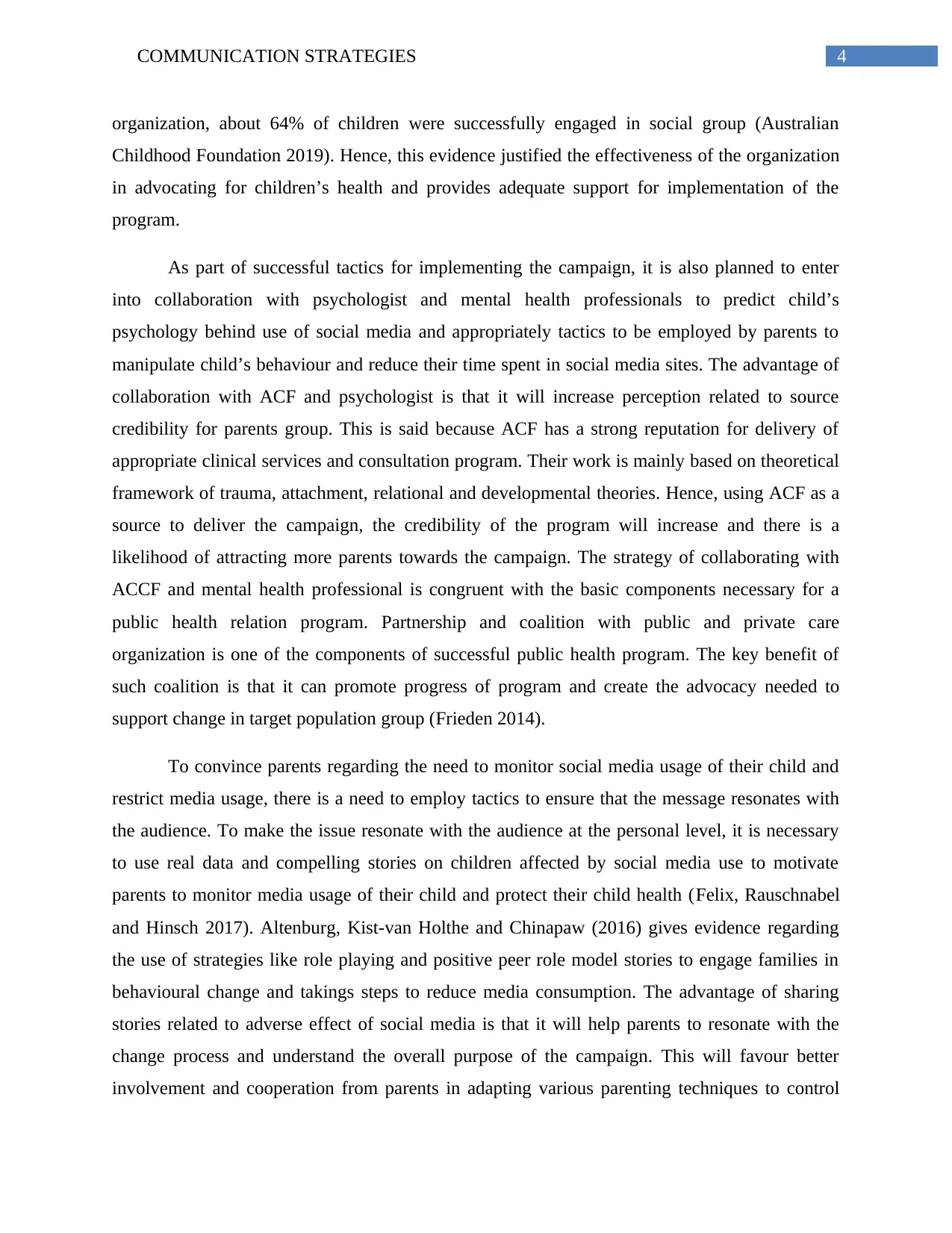
4COMMUNICATION STRATEGIES
organization, about 64% of children were successfully engaged in social group (Australian
Childhood Foundation 2019). Hence, this evidence justified the effectiveness of the organization
in advocating for children’s health and provides adequate support for implementation of the
program.
As part of successful tactics for implementing the campaign, it is also planned to enter
into collaboration with psychologist and mental health professionals to predict child’s
psychology behind use of social media and appropriately tactics to be employed by parents to
manipulate child’s behaviour and reduce their time spent in social media sites. The advantage of
collaboration with ACF and psychologist is that it will increase perception related to source
credibility for parents group. This is said because ACF has a strong reputation for delivery of
appropriate clinical services and consultation program. Their work is mainly based on theoretical
framework of trauma, attachment, relational and developmental theories. Hence, using ACF as a
source to deliver the campaign, the credibility of the program will increase and there is a
likelihood of attracting more parents towards the campaign. The strategy of collaborating with
ACCF and mental health professional is congruent with the basic components necessary for a
public health relation program. Partnership and coalition with public and private care
organization is one of the components of successful public health program. The key benefit of
such coalition is that it can promote progress of program and create the advocacy needed to
support change in target population group (Frieden 2014).
To convince parents regarding the need to monitor social media usage of their child and
restrict media usage, there is a need to employ tactics to ensure that the message resonates with
the audience. To make the issue resonate with the audience at the personal level, it is necessary
to use real data and compelling stories on children affected by social media use to motivate
parents to monitor media usage of their child and protect their child health (Felix, Rauschnabel
and Hinsch 2017). Altenburg, Kist-van Holthe and Chinapaw (2016) gives evidence regarding
the use of strategies like role playing and positive peer role model stories to engage families in
behavioural change and takings steps to reduce media consumption. The advantage of sharing
stories related to adverse effect of social media is that it will help parents to resonate with the
change process and understand the overall purpose of the campaign. This will favour better
involvement and cooperation from parents in adapting various parenting techniques to control
organization, about 64% of children were successfully engaged in social group (Australian
Childhood Foundation 2019). Hence, this evidence justified the effectiveness of the organization
in advocating for children’s health and provides adequate support for implementation of the
program.
As part of successful tactics for implementing the campaign, it is also planned to enter
into collaboration with psychologist and mental health professionals to predict child’s
psychology behind use of social media and appropriately tactics to be employed by parents to
manipulate child’s behaviour and reduce their time spent in social media sites. The advantage of
collaboration with ACF and psychologist is that it will increase perception related to source
credibility for parents group. This is said because ACF has a strong reputation for delivery of
appropriate clinical services and consultation program. Their work is mainly based on theoretical
framework of trauma, attachment, relational and developmental theories. Hence, using ACF as a
source to deliver the campaign, the credibility of the program will increase and there is a
likelihood of attracting more parents towards the campaign. The strategy of collaborating with
ACCF and mental health professional is congruent with the basic components necessary for a
public health relation program. Partnership and coalition with public and private care
organization is one of the components of successful public health program. The key benefit of
such coalition is that it can promote progress of program and create the advocacy needed to
support change in target population group (Frieden 2014).
To convince parents regarding the need to monitor social media usage of their child and
restrict media usage, there is a need to employ tactics to ensure that the message resonates with
the audience. To make the issue resonate with the audience at the personal level, it is necessary
to use real data and compelling stories on children affected by social media use to motivate
parents to monitor media usage of their child and protect their child health (Felix, Rauschnabel
and Hinsch 2017). Altenburg, Kist-van Holthe and Chinapaw (2016) gives evidence regarding
the use of strategies like role playing and positive peer role model stories to engage families in
behavioural change and takings steps to reduce media consumption. The advantage of sharing
stories related to adverse effect of social media is that it will help parents to resonate with the
change process and understand the overall purpose of the campaign. This will favour better
involvement and cooperation from parents in adapting various parenting techniques to control
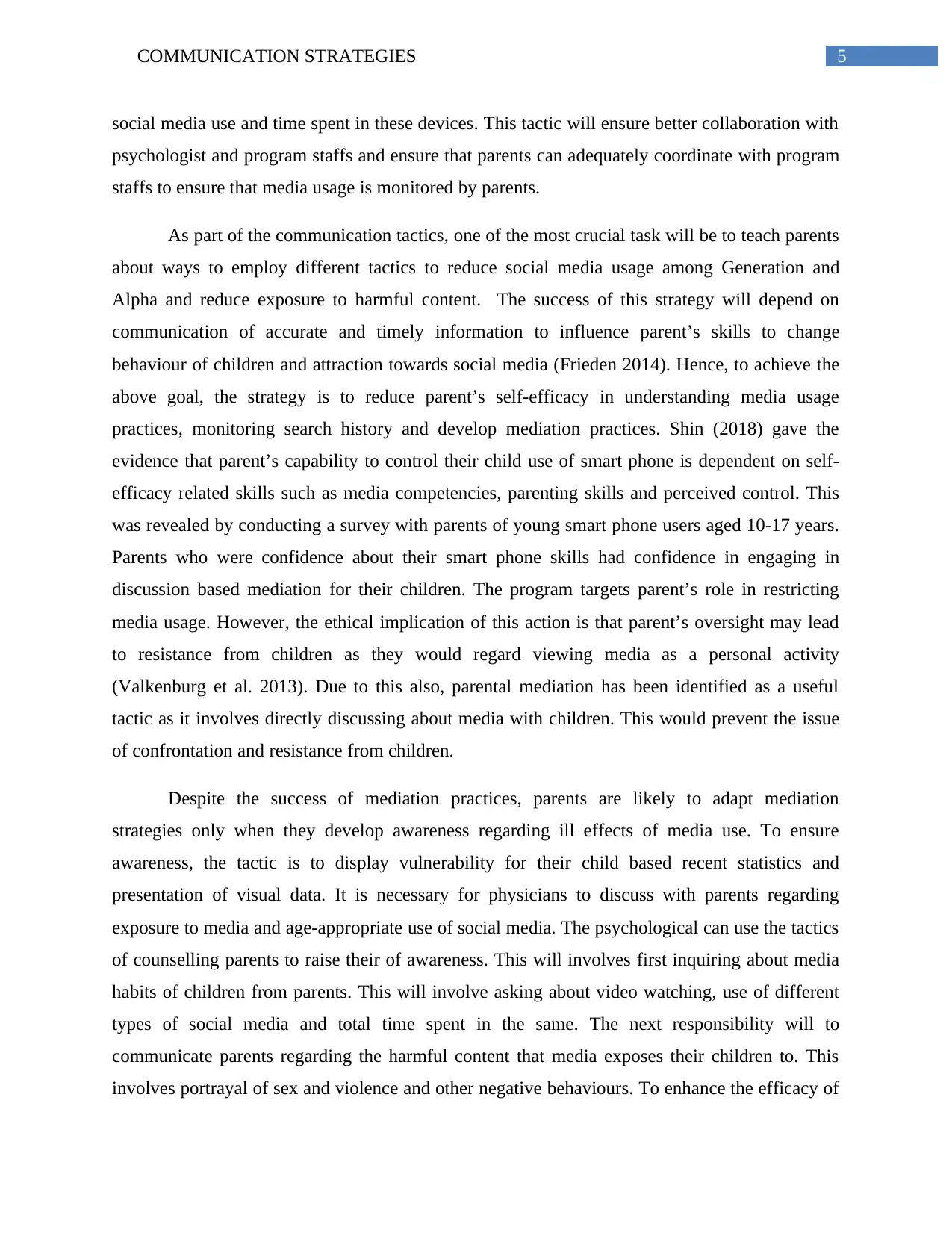
5COMMUNICATION STRATEGIES
social media use and time spent in these devices. This tactic will ensure better collaboration with
psychologist and program staffs and ensure that parents can adequately coordinate with program
staffs to ensure that media usage is monitored by parents.
As part of the communication tactics, one of the most crucial task will be to teach parents
about ways to employ different tactics to reduce social media usage among Generation and
Alpha and reduce exposure to harmful content. The success of this strategy will depend on
communication of accurate and timely information to influence parent’s skills to change
behaviour of children and attraction towards social media (Frieden 2014). Hence, to achieve the
above goal, the strategy is to reduce parent’s self-efficacy in understanding media usage
practices, monitoring search history and develop mediation practices. Shin (2018) gave the
evidence that parent’s capability to control their child use of smart phone is dependent on self-
efficacy related skills such as media competencies, parenting skills and perceived control. This
was revealed by conducting a survey with parents of young smart phone users aged 10-17 years.
Parents who were confidence about their smart phone skills had confidence in engaging in
discussion based mediation for their children. The program targets parent’s role in restricting
media usage. However, the ethical implication of this action is that parent’s oversight may lead
to resistance from children as they would regard viewing media as a personal activity
(Valkenburg et al. 2013). Due to this also, parental mediation has been identified as a useful
tactic as it involves directly discussing about media with children. This would prevent the issue
of confrontation and resistance from children.
Despite the success of mediation practices, parents are likely to adapt mediation
strategies only when they develop awareness regarding ill effects of media use. To ensure
awareness, the tactic is to display vulnerability for their child based recent statistics and
presentation of visual data. It is necessary for physicians to discuss with parents regarding
exposure to media and age-appropriate use of social media. The psychological can use the tactics
of counselling parents to raise their of awareness. This will involves first inquiring about media
habits of children from parents. This will involve asking about video watching, use of different
types of social media and total time spent in the same. The next responsibility will to
communicate parents regarding the harmful content that media exposes their children to. This
involves portrayal of sex and violence and other negative behaviours. To enhance the efficacy of
social media use and time spent in these devices. This tactic will ensure better collaboration with
psychologist and program staffs and ensure that parents can adequately coordinate with program
staffs to ensure that media usage is monitored by parents.
As part of the communication tactics, one of the most crucial task will be to teach parents
about ways to employ different tactics to reduce social media usage among Generation and
Alpha and reduce exposure to harmful content. The success of this strategy will depend on
communication of accurate and timely information to influence parent’s skills to change
behaviour of children and attraction towards social media (Frieden 2014). Hence, to achieve the
above goal, the strategy is to reduce parent’s self-efficacy in understanding media usage
practices, monitoring search history and develop mediation practices. Shin (2018) gave the
evidence that parent’s capability to control their child use of smart phone is dependent on self-
efficacy related skills such as media competencies, parenting skills and perceived control. This
was revealed by conducting a survey with parents of young smart phone users aged 10-17 years.
Parents who were confidence about their smart phone skills had confidence in engaging in
discussion based mediation for their children. The program targets parent’s role in restricting
media usage. However, the ethical implication of this action is that parent’s oversight may lead
to resistance from children as they would regard viewing media as a personal activity
(Valkenburg et al. 2013). Due to this also, parental mediation has been identified as a useful
tactic as it involves directly discussing about media with children. This would prevent the issue
of confrontation and resistance from children.
Despite the success of mediation practices, parents are likely to adapt mediation
strategies only when they develop awareness regarding ill effects of media use. To ensure
awareness, the tactic is to display vulnerability for their child based recent statistics and
presentation of visual data. It is necessary for physicians to discuss with parents regarding
exposure to media and age-appropriate use of social media. The psychological can use the tactics
of counselling parents to raise their of awareness. This will involves first inquiring about media
habits of children from parents. This will involve asking about video watching, use of different
types of social media and total time spent in the same. The next responsibility will to
communicate parents regarding the harmful content that media exposes their children to. This
involves portrayal of sex and violence and other negative behaviours. To enhance the efficacy of
⊘ This is a preview!⊘
Do you want full access?
Subscribe today to unlock all pages.

Trusted by 1+ million students worldwide
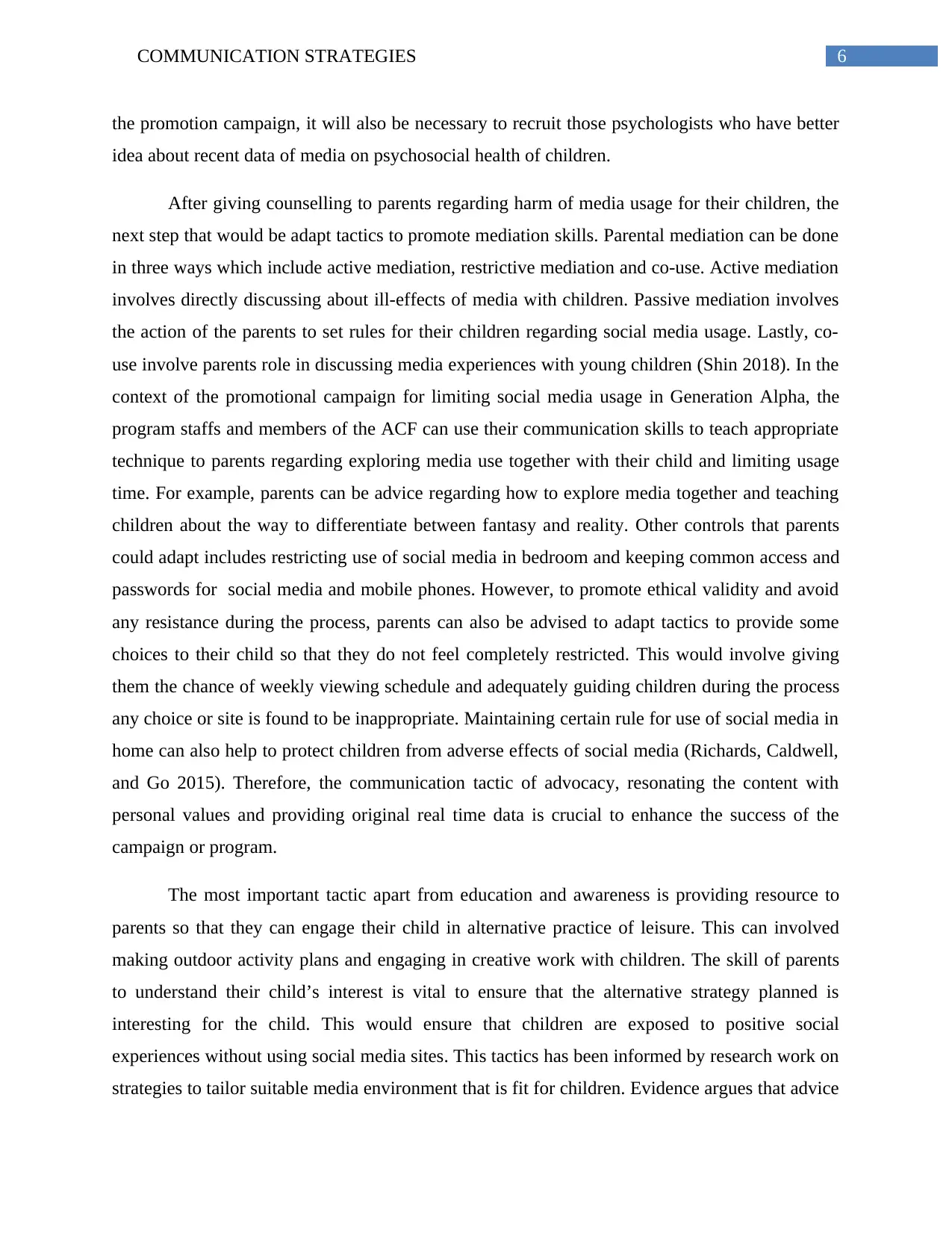
6COMMUNICATION STRATEGIES
the promotion campaign, it will also be necessary to recruit those psychologists who have better
idea about recent data of media on psychosocial health of children.
After giving counselling to parents regarding harm of media usage for their children, the
next step that would be adapt tactics to promote mediation skills. Parental mediation can be done
in three ways which include active mediation, restrictive mediation and co-use. Active mediation
involves directly discussing about ill-effects of media with children. Passive mediation involves
the action of the parents to set rules for their children regarding social media usage. Lastly, co-
use involve parents role in discussing media experiences with young children (Shin 2018). In the
context of the promotional campaign for limiting social media usage in Generation Alpha, the
program staffs and members of the ACF can use their communication skills to teach appropriate
technique to parents regarding exploring media use together with their child and limiting usage
time. For example, parents can be advice regarding how to explore media together and teaching
children about the way to differentiate between fantasy and reality. Other controls that parents
could adapt includes restricting use of social media in bedroom and keeping common access and
passwords for social media and mobile phones. However, to promote ethical validity and avoid
any resistance during the process, parents can also be advised to adapt tactics to provide some
choices to their child so that they do not feel completely restricted. This would involve giving
them the chance of weekly viewing schedule and adequately guiding children during the process
any choice or site is found to be inappropriate. Maintaining certain rule for use of social media in
home can also help to protect children from adverse effects of social media (Richards, Caldwell,
and Go 2015). Therefore, the communication tactic of advocacy, resonating the content with
personal values and providing original real time data is crucial to enhance the success of the
campaign or program.
The most important tactic apart from education and awareness is providing resource to
parents so that they can engage their child in alternative practice of leisure. This can involved
making outdoor activity plans and engaging in creative work with children. The skill of parents
to understand their child’s interest is vital to ensure that the alternative strategy planned is
interesting for the child. This would ensure that children are exposed to positive social
experiences without using social media sites. This tactics has been informed by research work on
strategies to tailor suitable media environment that is fit for children. Evidence argues that advice
the promotion campaign, it will also be necessary to recruit those psychologists who have better
idea about recent data of media on psychosocial health of children.
After giving counselling to parents regarding harm of media usage for their children, the
next step that would be adapt tactics to promote mediation skills. Parental mediation can be done
in three ways which include active mediation, restrictive mediation and co-use. Active mediation
involves directly discussing about ill-effects of media with children. Passive mediation involves
the action of the parents to set rules for their children regarding social media usage. Lastly, co-
use involve parents role in discussing media experiences with young children (Shin 2018). In the
context of the promotional campaign for limiting social media usage in Generation Alpha, the
program staffs and members of the ACF can use their communication skills to teach appropriate
technique to parents regarding exploring media use together with their child and limiting usage
time. For example, parents can be advice regarding how to explore media together and teaching
children about the way to differentiate between fantasy and reality. Other controls that parents
could adapt includes restricting use of social media in bedroom and keeping common access and
passwords for social media and mobile phones. However, to promote ethical validity and avoid
any resistance during the process, parents can also be advised to adapt tactics to provide some
choices to their child so that they do not feel completely restricted. This would involve giving
them the chance of weekly viewing schedule and adequately guiding children during the process
any choice or site is found to be inappropriate. Maintaining certain rule for use of social media in
home can also help to protect children from adverse effects of social media (Richards, Caldwell,
and Go 2015). Therefore, the communication tactic of advocacy, resonating the content with
personal values and providing original real time data is crucial to enhance the success of the
campaign or program.
The most important tactic apart from education and awareness is providing resource to
parents so that they can engage their child in alternative practice of leisure. This can involved
making outdoor activity plans and engaging in creative work with children. The skill of parents
to understand their child’s interest is vital to ensure that the alternative strategy planned is
interesting for the child. This would ensure that children are exposed to positive social
experiences without using social media sites. This tactics has been informed by research work on
strategies to tailor suitable media environment that is fit for children. Evidence argues that advice
Paraphrase This Document
Need a fresh take? Get an instant paraphrase of this document with our AI Paraphraser
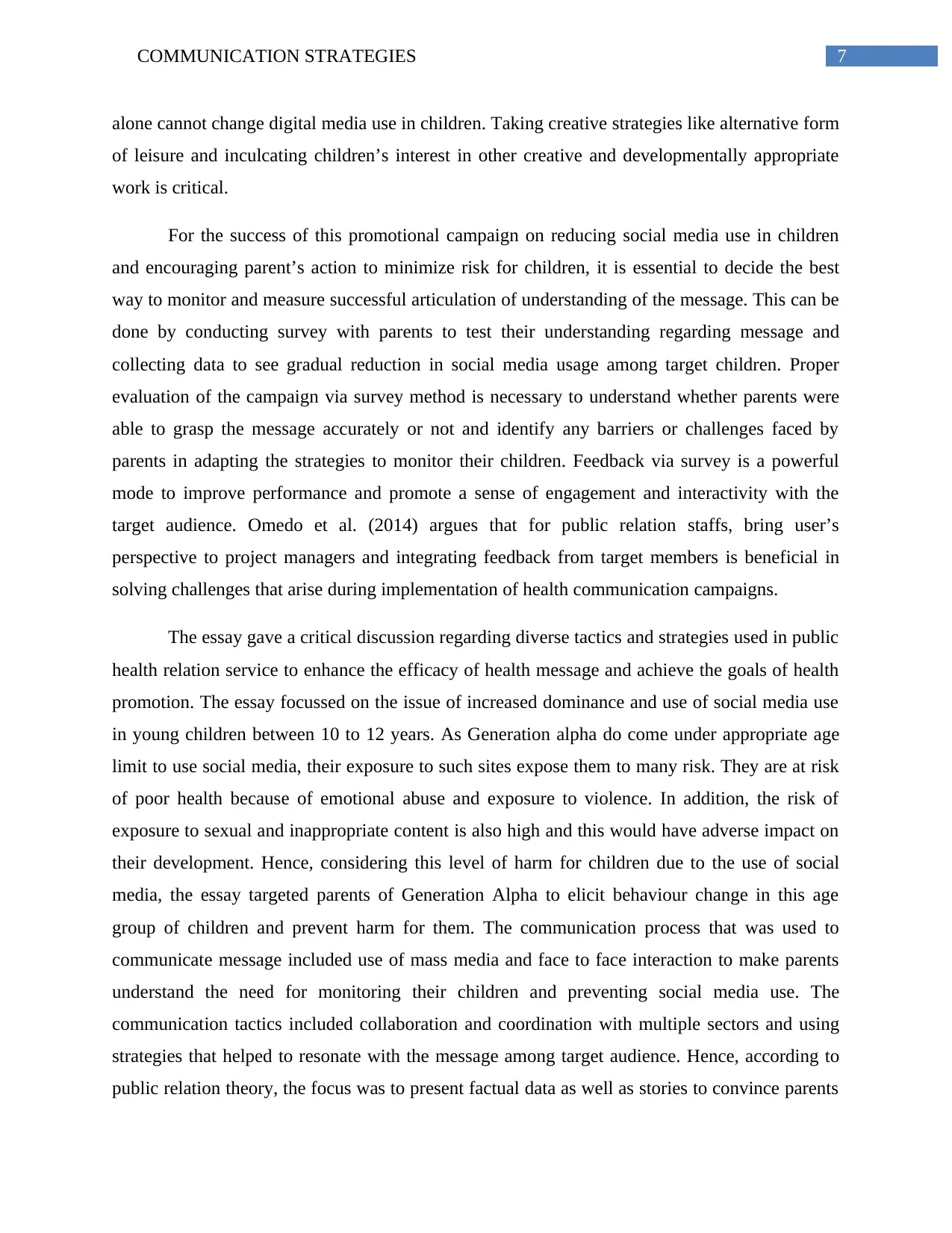
7COMMUNICATION STRATEGIES
alone cannot change digital media use in children. Taking creative strategies like alternative form
of leisure and inculcating children’s interest in other creative and developmentally appropriate
work is critical.
For the success of this promotional campaign on reducing social media use in children
and encouraging parent’s action to minimize risk for children, it is essential to decide the best
way to monitor and measure successful articulation of understanding of the message. This can be
done by conducting survey with parents to test their understanding regarding message and
collecting data to see gradual reduction in social media usage among target children. Proper
evaluation of the campaign via survey method is necessary to understand whether parents were
able to grasp the message accurately or not and identify any barriers or challenges faced by
parents in adapting the strategies to monitor their children. Feedback via survey is a powerful
mode to improve performance and promote a sense of engagement and interactivity with the
target audience. Omedo et al. (2014) argues that for public relation staffs, bring user’s
perspective to project managers and integrating feedback from target members is beneficial in
solving challenges that arise during implementation of health communication campaigns.
The essay gave a critical discussion regarding diverse tactics and strategies used in public
health relation service to enhance the efficacy of health message and achieve the goals of health
promotion. The essay focussed on the issue of increased dominance and use of social media use
in young children between 10 to 12 years. As Generation alpha do come under appropriate age
limit to use social media, their exposure to such sites expose them to many risk. They are at risk
of poor health because of emotional abuse and exposure to violence. In addition, the risk of
exposure to sexual and inappropriate content is also high and this would have adverse impact on
their development. Hence, considering this level of harm for children due to the use of social
media, the essay targeted parents of Generation Alpha to elicit behaviour change in this age
group of children and prevent harm for them. The communication process that was used to
communicate message included use of mass media and face to face interaction to make parents
understand the need for monitoring their children and preventing social media use. The
communication tactics included collaboration and coordination with multiple sectors and using
strategies that helped to resonate with the message among target audience. Hence, according to
public relation theory, the focus was to present factual data as well as stories to convince parents
alone cannot change digital media use in children. Taking creative strategies like alternative form
of leisure and inculcating children’s interest in other creative and developmentally appropriate
work is critical.
For the success of this promotional campaign on reducing social media use in children
and encouraging parent’s action to minimize risk for children, it is essential to decide the best
way to monitor and measure successful articulation of understanding of the message. This can be
done by conducting survey with parents to test their understanding regarding message and
collecting data to see gradual reduction in social media usage among target children. Proper
evaluation of the campaign via survey method is necessary to understand whether parents were
able to grasp the message accurately or not and identify any barriers or challenges faced by
parents in adapting the strategies to monitor their children. Feedback via survey is a powerful
mode to improve performance and promote a sense of engagement and interactivity with the
target audience. Omedo et al. (2014) argues that for public relation staffs, bring user’s
perspective to project managers and integrating feedback from target members is beneficial in
solving challenges that arise during implementation of health communication campaigns.
The essay gave a critical discussion regarding diverse tactics and strategies used in public
health relation service to enhance the efficacy of health message and achieve the goals of health
promotion. The essay focussed on the issue of increased dominance and use of social media use
in young children between 10 to 12 years. As Generation alpha do come under appropriate age
limit to use social media, their exposure to such sites expose them to many risk. They are at risk
of poor health because of emotional abuse and exposure to violence. In addition, the risk of
exposure to sexual and inappropriate content is also high and this would have adverse impact on
their development. Hence, considering this level of harm for children due to the use of social
media, the essay targeted parents of Generation Alpha to elicit behaviour change in this age
group of children and prevent harm for them. The communication process that was used to
communicate message included use of mass media and face to face interaction to make parents
understand the need for monitoring their children and preventing social media use. The
communication tactics included collaboration and coordination with multiple sectors and using
strategies that helped to resonate with the message among target audience. Hence, according to
public relation theory, the focus was to present factual data as well as stories to convince parents
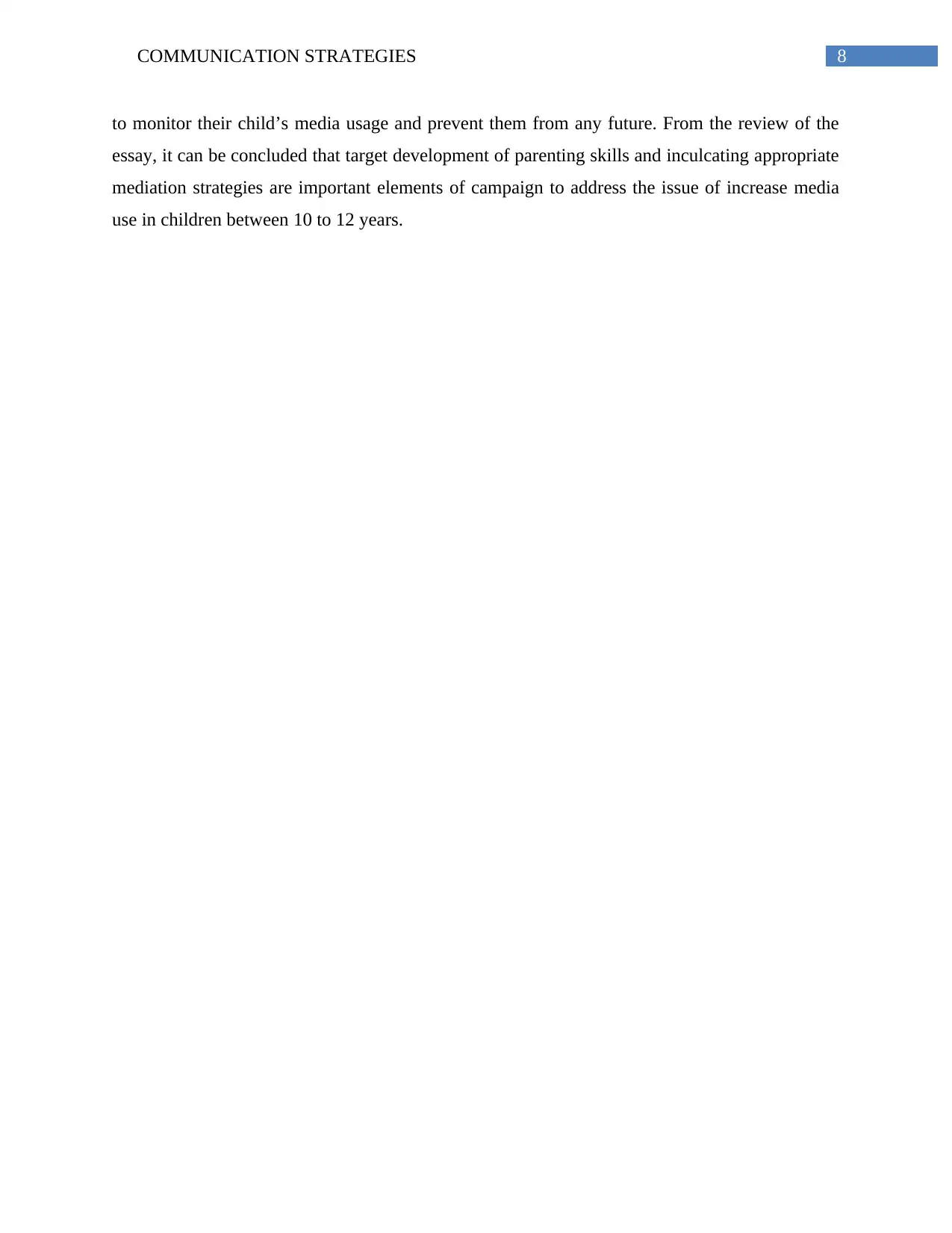
8COMMUNICATION STRATEGIES
to monitor their child’s media usage and prevent them from any future. From the review of the
essay, it can be concluded that target development of parenting skills and inculcating appropriate
mediation strategies are important elements of campaign to address the issue of increase media
use in children between 10 to 12 years.
to monitor their child’s media usage and prevent them from any future. From the review of the
essay, it can be concluded that target development of parenting skills and inculcating appropriate
mediation strategies are important elements of campaign to address the issue of increase media
use in children between 10 to 12 years.
⊘ This is a preview!⊘
Do you want full access?
Subscribe today to unlock all pages.

Trusted by 1+ million students worldwide
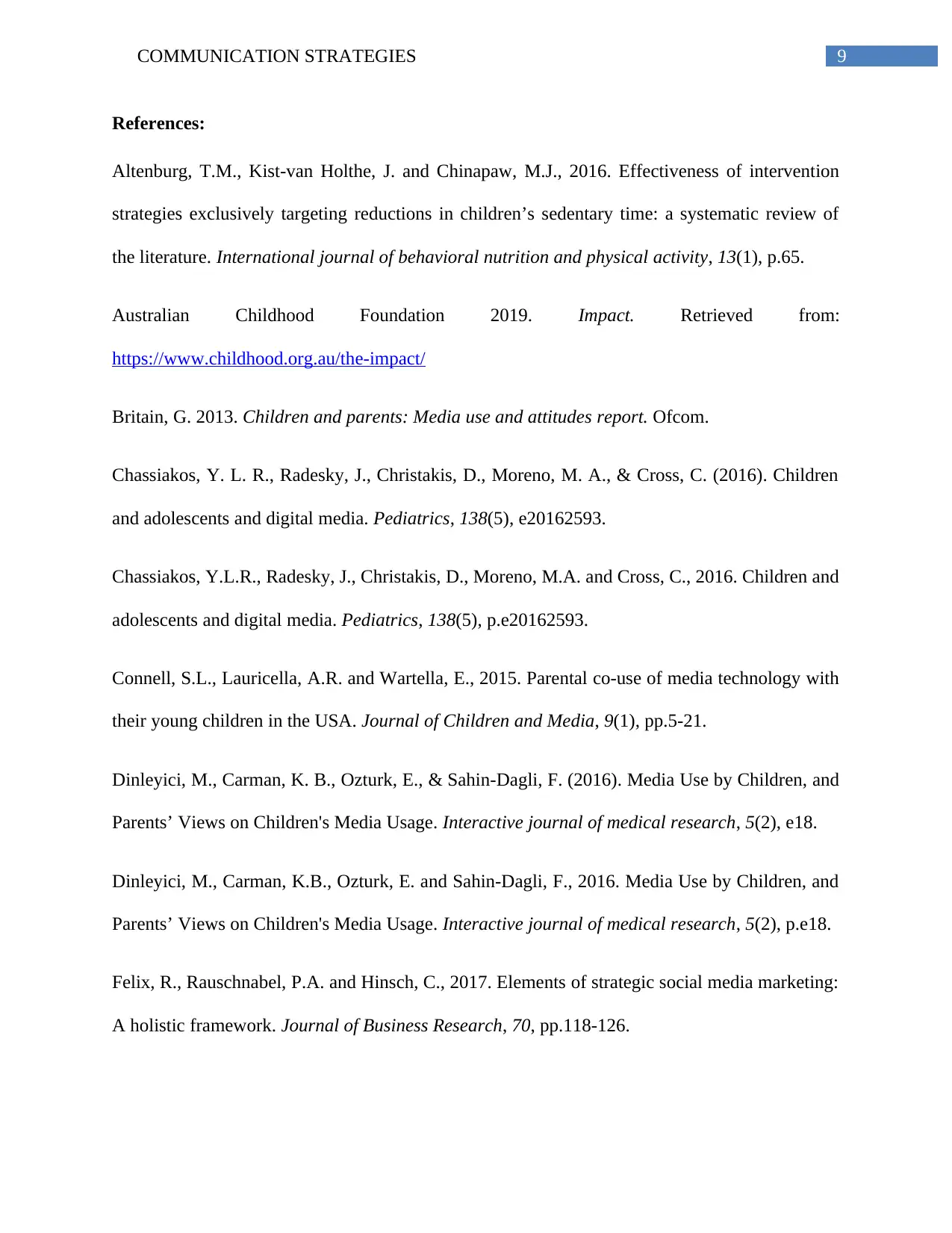
9COMMUNICATION STRATEGIES
References:
Altenburg, T.M., Kist-van Holthe, J. and Chinapaw, M.J., 2016. Effectiveness of intervention
strategies exclusively targeting reductions in children’s sedentary time: a systematic review of
the literature. International journal of behavioral nutrition and physical activity, 13(1), p.65.
Australian Childhood Foundation 2019. Impact. Retrieved from:
https://www.childhood.org.au/the-impact/
Britain, G. 2013. Children and parents: Media use and attitudes report. Ofcom.
Chassiakos, Y. L. R., Radesky, J., Christakis, D., Moreno, M. A., & Cross, C. (2016). Children
and adolescents and digital media. Pediatrics, 138(5), e20162593.
Chassiakos, Y.L.R., Radesky, J., Christakis, D., Moreno, M.A. and Cross, C., 2016. Children and
adolescents and digital media. Pediatrics, 138(5), p.e20162593.
Connell, S.L., Lauricella, A.R. and Wartella, E., 2015. Parental co-use of media technology with
their young children in the USA. Journal of Children and Media, 9(1), pp.5-21.
Dinleyici, M., Carman, K. B., Ozturk, E., & Sahin-Dagli, F. (2016). Media Use by Children, and
Parents’ Views on Children's Media Usage. Interactive journal of medical research, 5(2), e18.
Dinleyici, M., Carman, K.B., Ozturk, E. and Sahin-Dagli, F., 2016. Media Use by Children, and
Parents’ Views on Children's Media Usage. Interactive journal of medical research, 5(2), p.e18.
Felix, R., Rauschnabel, P.A. and Hinsch, C., 2017. Elements of strategic social media marketing:
A holistic framework. Journal of Business Research, 70, pp.118-126.
References:
Altenburg, T.M., Kist-van Holthe, J. and Chinapaw, M.J., 2016. Effectiveness of intervention
strategies exclusively targeting reductions in children’s sedentary time: a systematic review of
the literature. International journal of behavioral nutrition and physical activity, 13(1), p.65.
Australian Childhood Foundation 2019. Impact. Retrieved from:
https://www.childhood.org.au/the-impact/
Britain, G. 2013. Children and parents: Media use and attitudes report. Ofcom.
Chassiakos, Y. L. R., Radesky, J., Christakis, D., Moreno, M. A., & Cross, C. (2016). Children
and adolescents and digital media. Pediatrics, 138(5), e20162593.
Chassiakos, Y.L.R., Radesky, J., Christakis, D., Moreno, M.A. and Cross, C., 2016. Children and
adolescents and digital media. Pediatrics, 138(5), p.e20162593.
Connell, S.L., Lauricella, A.R. and Wartella, E., 2015. Parental co-use of media technology with
their young children in the USA. Journal of Children and Media, 9(1), pp.5-21.
Dinleyici, M., Carman, K. B., Ozturk, E., & Sahin-Dagli, F. (2016). Media Use by Children, and
Parents’ Views on Children's Media Usage. Interactive journal of medical research, 5(2), e18.
Dinleyici, M., Carman, K.B., Ozturk, E. and Sahin-Dagli, F., 2016. Media Use by Children, and
Parents’ Views on Children's Media Usage. Interactive journal of medical research, 5(2), p.e18.
Felix, R., Rauschnabel, P.A. and Hinsch, C., 2017. Elements of strategic social media marketing:
A holistic framework. Journal of Business Research, 70, pp.118-126.
Paraphrase This Document
Need a fresh take? Get an instant paraphrase of this document with our AI Paraphraser
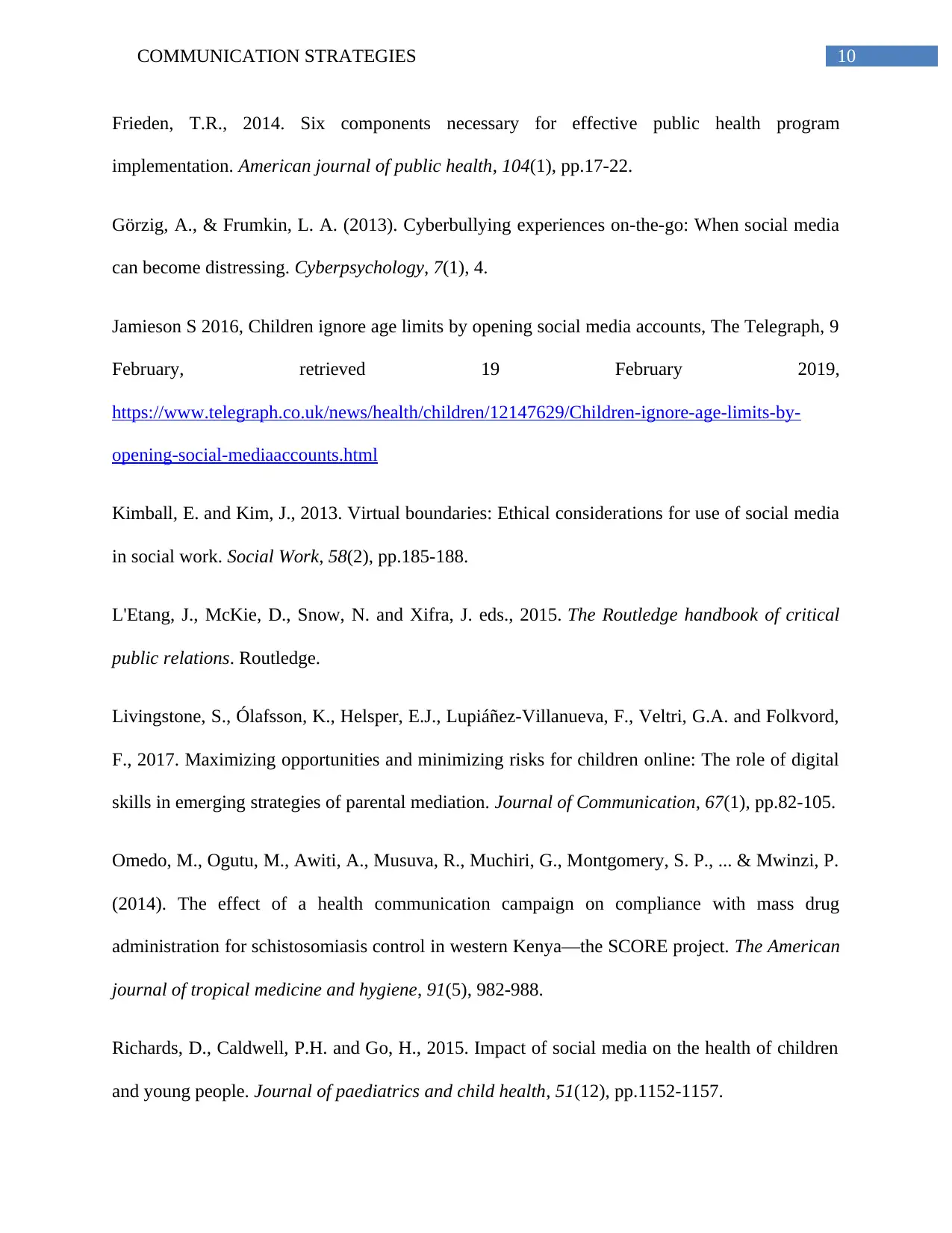
10COMMUNICATION STRATEGIES
Frieden, T.R., 2014. Six components necessary for effective public health program
implementation. American journal of public health, 104(1), pp.17-22.
Görzig, A., & Frumkin, L. A. (2013). Cyberbullying experiences on-the-go: When social media
can become distressing. Cyberpsychology, 7(1), 4.
Jamieson S 2016, Children ignore age limits by opening social media accounts, The Telegraph, 9
February, retrieved 19 February 2019,
https://www.telegraph.co.uk/news/health/children/12147629/Children-ignore-age-limits-by-
opening-social-mediaaccounts.html
Kimball, E. and Kim, J., 2013. Virtual boundaries: Ethical considerations for use of social media
in social work. Social Work, 58(2), pp.185-188.
L'Etang, J., McKie, D., Snow, N. and Xifra, J. eds., 2015. The Routledge handbook of critical
public relations. Routledge.
Livingstone, S., Ólafsson, K., Helsper, E.J., Lupiáñez-Villanueva, F., Veltri, G.A. and Folkvord,
F., 2017. Maximizing opportunities and minimizing risks for children online: The role of digital
skills in emerging strategies of parental mediation. Journal of Communication, 67(1), pp.82-105.
Omedo, M., Ogutu, M., Awiti, A., Musuva, R., Muchiri, G., Montgomery, S. P., ... & Mwinzi, P.
(2014). The effect of a health communication campaign on compliance with mass drug
administration for schistosomiasis control in western Kenya—the SCORE project. The American
journal of tropical medicine and hygiene, 91(5), 982-988.
Richards, D., Caldwell, P.H. and Go, H., 2015. Impact of social media on the health of children
and young people. Journal of paediatrics and child health, 51(12), pp.1152-1157.
Frieden, T.R., 2014. Six components necessary for effective public health program
implementation. American journal of public health, 104(1), pp.17-22.
Görzig, A., & Frumkin, L. A. (2013). Cyberbullying experiences on-the-go: When social media
can become distressing. Cyberpsychology, 7(1), 4.
Jamieson S 2016, Children ignore age limits by opening social media accounts, The Telegraph, 9
February, retrieved 19 February 2019,
https://www.telegraph.co.uk/news/health/children/12147629/Children-ignore-age-limits-by-
opening-social-mediaaccounts.html
Kimball, E. and Kim, J., 2013. Virtual boundaries: Ethical considerations for use of social media
in social work. Social Work, 58(2), pp.185-188.
L'Etang, J., McKie, D., Snow, N. and Xifra, J. eds., 2015. The Routledge handbook of critical
public relations. Routledge.
Livingstone, S., Ólafsson, K., Helsper, E.J., Lupiáñez-Villanueva, F., Veltri, G.A. and Folkvord,
F., 2017. Maximizing opportunities and minimizing risks for children online: The role of digital
skills in emerging strategies of parental mediation. Journal of Communication, 67(1), pp.82-105.
Omedo, M., Ogutu, M., Awiti, A., Musuva, R., Muchiri, G., Montgomery, S. P., ... & Mwinzi, P.
(2014). The effect of a health communication campaign on compliance with mass drug
administration for schistosomiasis control in western Kenya—the SCORE project. The American
journal of tropical medicine and hygiene, 91(5), 982-988.
Richards, D., Caldwell, P.H. and Go, H., 2015. Impact of social media on the health of children
and young people. Journal of paediatrics and child health, 51(12), pp.1152-1157.
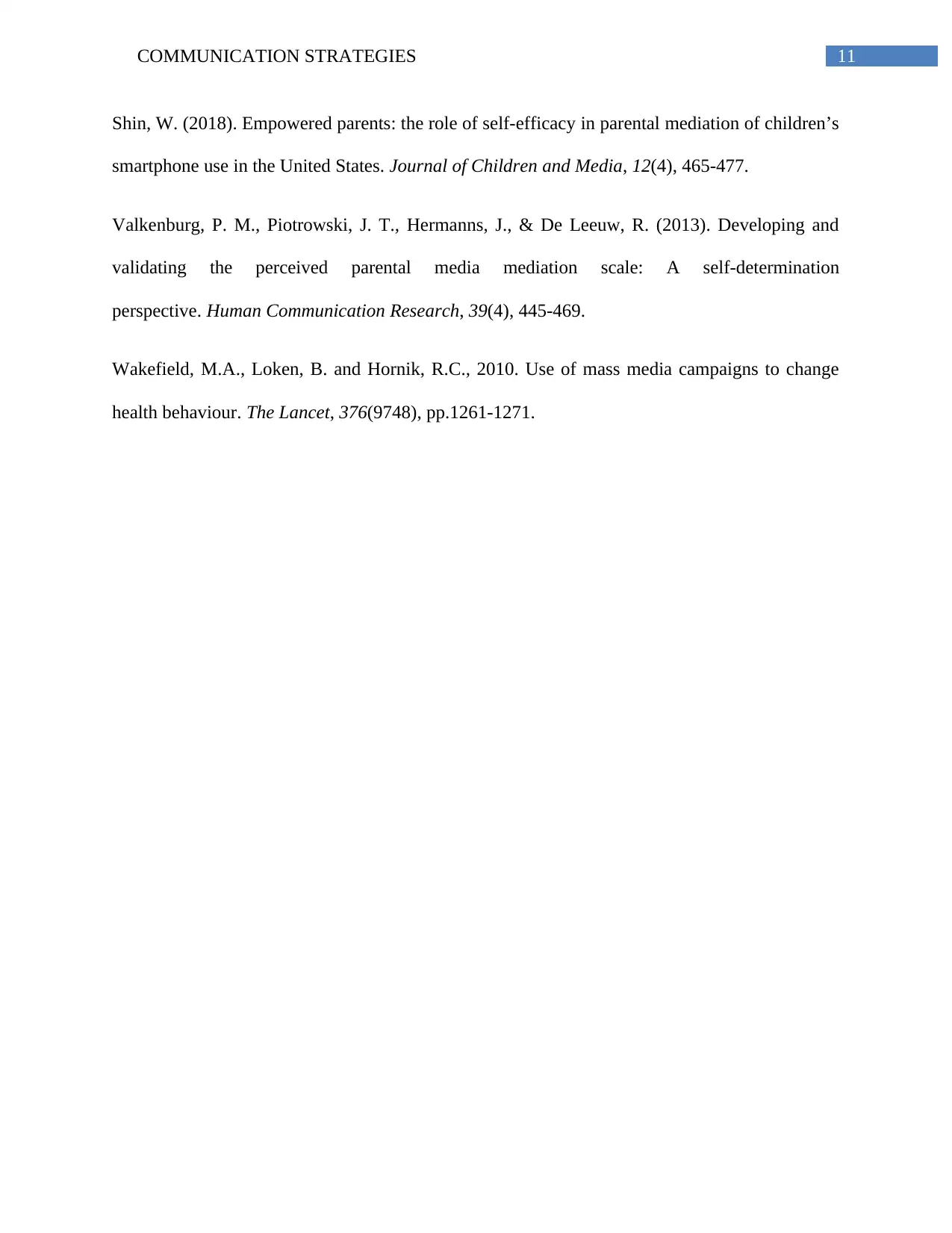
11COMMUNICATION STRATEGIES
Shin, W. (2018). Empowered parents: the role of self-efficacy in parental mediation of children’s
smartphone use in the United States. Journal of Children and Media, 12(4), 465-477.
Valkenburg, P. M., Piotrowski, J. T., Hermanns, J., & De Leeuw, R. (2013). Developing and
validating the perceived parental media mediation scale: A self-determination
perspective. Human Communication Research, 39(4), 445-469.
Wakefield, M.A., Loken, B. and Hornik, R.C., 2010. Use of mass media campaigns to change
health behaviour. The Lancet, 376(9748), pp.1261-1271.
Shin, W. (2018). Empowered parents: the role of self-efficacy in parental mediation of children’s
smartphone use in the United States. Journal of Children and Media, 12(4), 465-477.
Valkenburg, P. M., Piotrowski, J. T., Hermanns, J., & De Leeuw, R. (2013). Developing and
validating the perceived parental media mediation scale: A self-determination
perspective. Human Communication Research, 39(4), 445-469.
Wakefield, M.A., Loken, B. and Hornik, R.C., 2010. Use of mass media campaigns to change
health behaviour. The Lancet, 376(9748), pp.1261-1271.
⊘ This is a preview!⊘
Do you want full access?
Subscribe today to unlock all pages.

Trusted by 1+ million students worldwide
1 out of 12
Related Documents
Your All-in-One AI-Powered Toolkit for Academic Success.
+13062052269
info@desklib.com
Available 24*7 on WhatsApp / Email
![[object Object]](/_next/static/media/star-bottom.7253800d.svg)
Unlock your academic potential
Copyright © 2020–2025 A2Z Services. All Rights Reserved. Developed and managed by ZUCOL.





